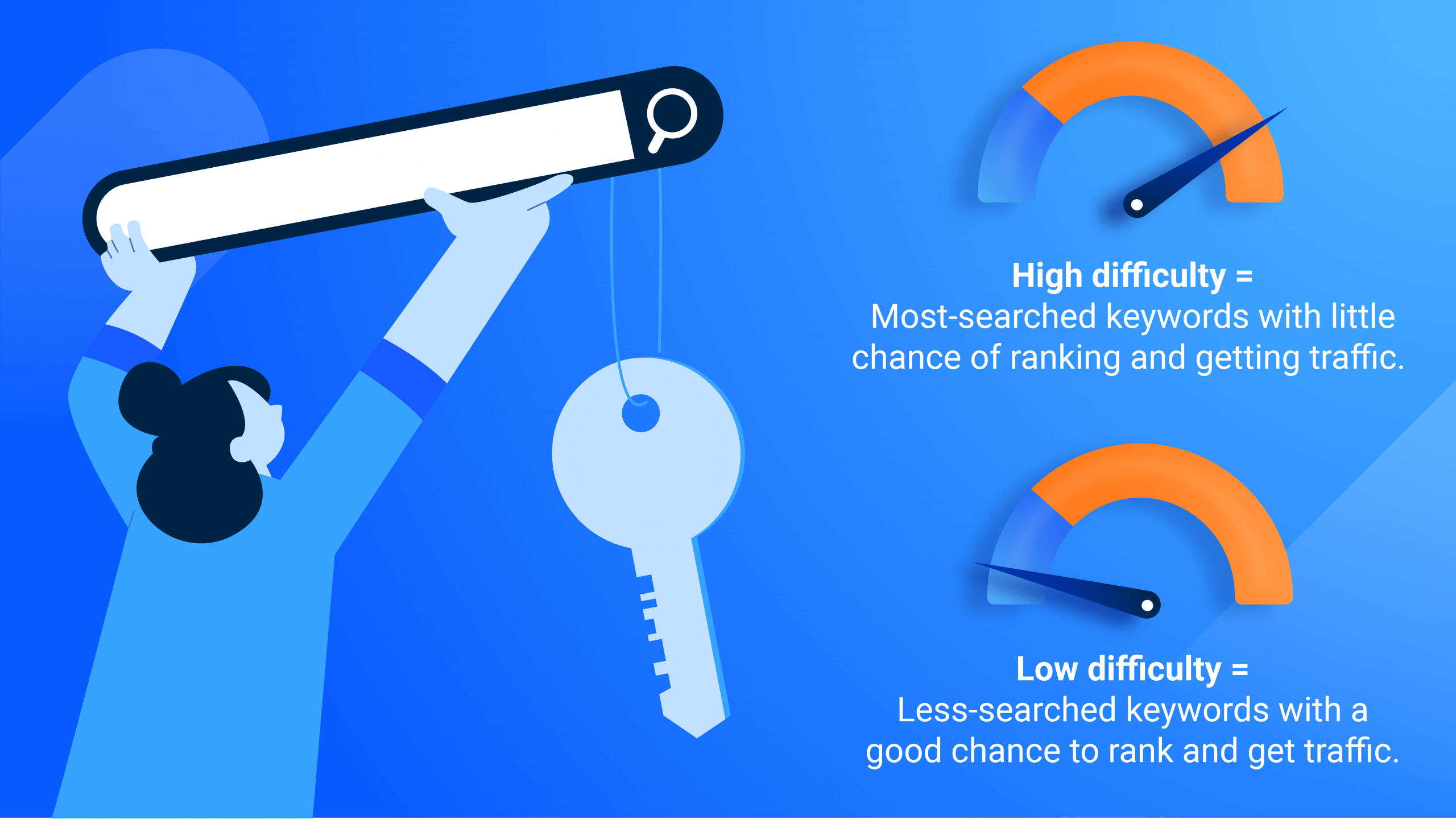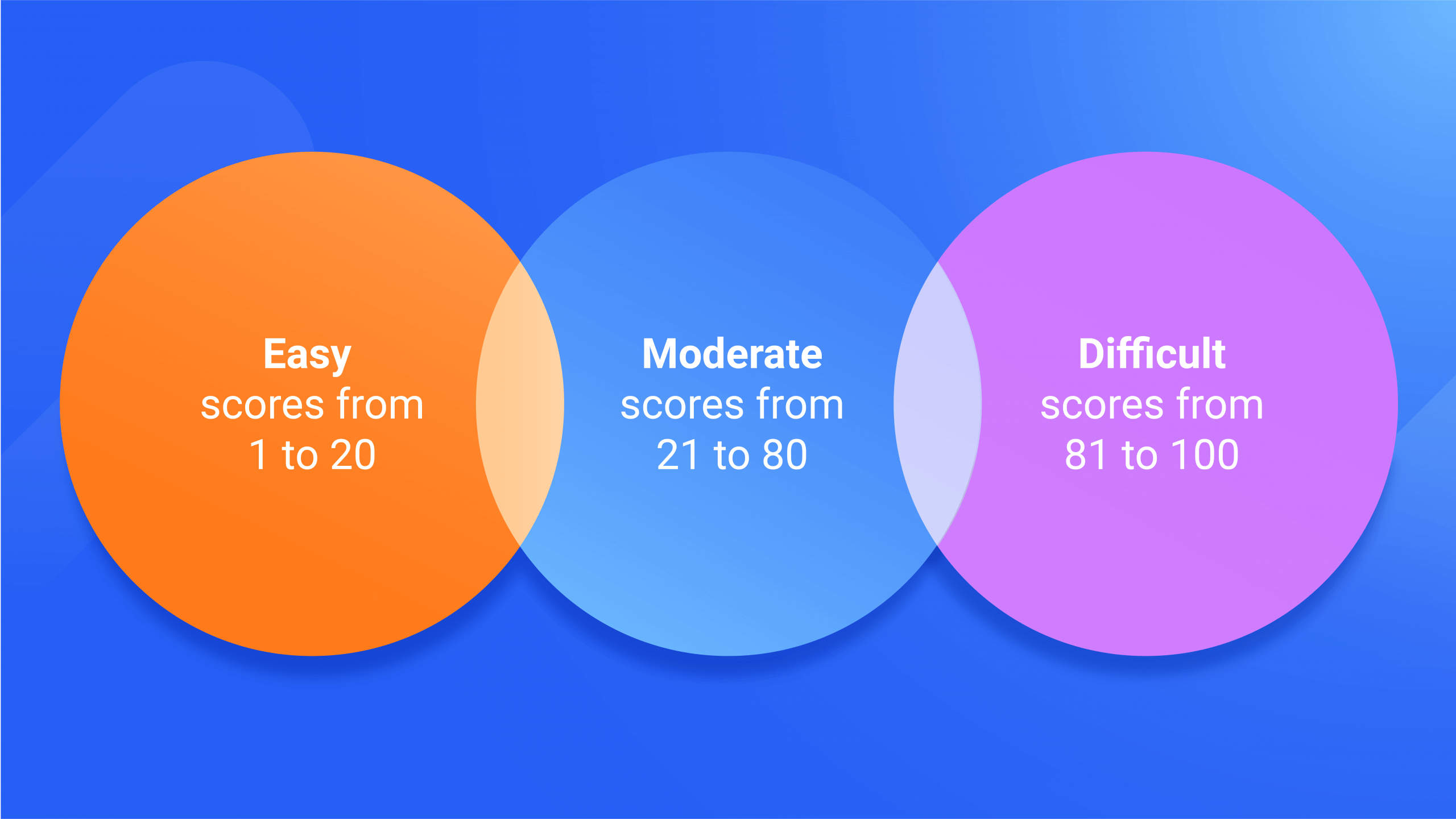5 Hacks to Make The Most of Keyword Difficulty

Keyword difficulty is a metric that measures the effort it would take for your content to rank on the first page of Google. It’s one of those metrics that’s really important, but also feels kind of vague.
I’m sure you know what I’m talking about. You can’t draw a mathematical conclusion. You still need to make estimations. But you know what, SEO professionals who aren’t taken aback by that find powerful ways to use it while eliminating the fogginess. You won’t learn this in a regular SEO course, though.
Today I’ll share some approaches to keyword difficulty in SEO that only successful professionals know about, plus the Similarweb features you need to build a long-term keyword strategy.
Why keyword difficulty matters for SEO
You’re knee-deep in your keyword research. Keyword difficulty is one of many metrics you’re measuring, analyzing, and correlating. Let’s quickly recap where it’s useful:
- To evaluate the competition for organic search
- To analyze your chances of ranking for a specific keyword
- To estimate the time and effort it’ll take to climb to the desired rank
- To relativize and provide context for traffic volume
- To map out your keyword strategy with a mix of difficulty levels
- To be able to close market gaps
How do you use keyword difficulty in your strategy?
We’ve all been told to stay away from high-difficulty keywords when we started working with the metric. The secret to getting traffic was finding relevant low-difficulty keywords.
High difficulty = most-searched keywords with little chance of ranking and getting traffic within a short period of time.
Low difficulty = less-searched keywords with a good chance to rank high quickly and get traffic.
As you get more experienced, you understand it’s not that simple. You can’t simply ignore the difficult ones. For your keyword strategy to be effective, you need to create a well-balanced mix of keywords with different difficulty levels.
So, in the next section, I’ll show you how you can incorporate keywords with a high difficulty score and then how to use Similarweb to refine your keyword strategy. Ready?
Leverage keywords with a high difficulty score
The fact that they’re difficult to rank for doesn’t mean it’s impossible. It just takes more time and effort. And by that, I mean it can take years. If you get to the first page, that’s a huge success. So start early. Make a long-term plan.
But there are other reasons why you should incorporate these very relevant terms into your keyword strategy. Instead of looking at keywords on the page level, take a wholesome approach. Plan how pages support each other to build a solid SEO framework. As you keep adding and optimizing content, you gradually grow your authority and increase backlinks.
The most popular and challenging keywords form the center of your keyword strategy, even if you don’t directly target them. Most of the lower-difficulty keywords relate to them in one way or another. So you may as well start with the centerpiece and plan from there.
Identify high-value, high-difficulty keywords and build a long-term plan to incorporate them into your content again and again. Then watch how your content climbs the SERP ladder rank by rank.
Choose keywords that will always be relevant to your site content. These are usually the most commonly associated keywords with a specific topic or industry. They’re the roots that anchor your keyword strategy.
Find long-tail keywords with low SEO difficulty
Many of your initial low-difficulty keywords are long-tail keywords. Pick out the ones with the highest search volume that relate to the root keywords most directly. Then create content for the various terms, interlink them, and link them back to the roots. Over time you’ll build an entire library of content relevant to the topic and related to the high-difficulty keyword you’ve been avoiding.
Grab low-hanging fruit first. This way, you get better ROI to keep you going until you rank for the more difficult keywords. Tweet thisThis can include specialized articles for a smaller target audience or content on short-lived trends. The bonus here is that you can target highly specific audiences with super relevant content.
In practice, it’ll look like this: Cybersecurity is a high-difficulty keyword in computer electronics. But, if that’s what you offer, there’s no way around targeting the term. You need to find your niche in the vast cybersecurity landscape and research which long-tail keywords are most promising. This could include “why is cybersecurity important?” or “the best cybersecurity solutions for [industry]” or “latest cyberattacks in [country]”, and so on.
Once you understand the concept, it becomes clear that high and low difficulty keywords always need to go together. Your long-tail keywords-based content supports your high-difficulty keywords targeted pages. You target them simultaneously, but prioritization depends on additional factors, like the core of your business and brand authority.
For current benchmarks grab the Complete Guide to Keyword Difficulty.
Keyword difficulty analysis with Similarweb
On Similarweb, you’ll find the keyword difficulty score displayed in the keyword research tool and in the competitive analysis section.
In keyword research under these features:
- Keyword Gap
- Keyword Generator
- Keyword Overview (keyword analysis)
In competitive analysis under these features:
- Search
- Keywords
It’s a numeric score from 1 to 100, divided into easy, moderate, and difficult. This structure is simple to work with and explain to stakeholders who may demand clarifications.
Here’s a breakdown of the Similarweb keyword difficulty scoring system:
Easy – scores from 1 to 20
Keywords in this range have either very little or no competition at all. You won’t need to invest extensive resources to reach a rank on the SERP (search engine results page). Most of your relevant long-tail keywords will appear in this range. Remember to ensure there’s sufficient traffic.
Moderate – scores from 21 to 80
To rank for these keywords, some research and optimization are required. It may seem like a vast score range, but you really don’t need additional subcategories. In any case, you’ll consider the specific numeric score within this group of keywords.
Find out if the score is based on high domain authority or the number of backlinks or content quality, or all of them. Understand which steps you need to take to rank high. Find the most relevant secondary keywords and invest in link building.
Difficult – scores from 81 to 100
At this level, keywords typically also have the highest traffic potential. It will take considerably more time and effort to get to a high rank on the SERP. You’ll find a lot of generic terms in this category that are valuable, but may not be exclusive to your industry or business sector.
How does Similarweb calculate keyword difficulty?
Keyword difficulty is calculated by the quantity and quality of referring domains that lead to a keyword’s top results.
We look at the first results page on the search engine and check the number and quality of backlinks and referring domains for any result. Then, we use the first ten results to calculate how difficult it would be to get a ranking for a keyword.
But wait, isn’t that what other tools do? Yes, but the accuracy of the metric relies on the quality of the data the tool collects. And you already know that Similarweb data is accurate because of the variety and extent of sources. Now you can do all your SEO research as part of your digital marketing analysis with one tool.
5 hands-on tactics to use the Similarweb keyword difficulty score
I’ll walk you through five use cases for keyword difficulty and how to make the most out of the metric. Let’s start with the simple and move up to the more advanced uses.
1. Identify KD scores for your competitors’ top traffic-driving keywords
In the competitive analysis section, enter your closest competitors. Under search, go straight to keywords, or in the overview, scroll to top organic keywords and expand the view. You’ll receive a list of the top traffic-driving keywords, including a keyword difficulty score – use filters, such as branded or non-branded keywords, specific search engines or search types, and more.
The list shows you how difficult it is to rank for the keywords that drive the most traffic to your competitors. You can use the competitive traffic filter to find keyword opportunities, losses, wins, and highly competitive keywords. That way, you can upgrade your competitive keyword research, and identify the most critical keywords you need to incorporate into your strategy. Gauge your chance of getting traffic for them and how much time and effort it will take.
2. Discover additional potential keywords
One of the secrets to a successful keyword strategy? Pinpoint the keywords that meet all your requirements: high search volume from the right target audience with low keyword difficulty. No need to guess. Use the keyword generator to find additional opportunities.
Let’s say you’re investigating a specific keyword, i.e., “cybersecurity news” that you think your company should create content for. You realize the competition is more rigid than expected and the difficulty score is too high. Type the term in the search bar and get a list of related keywords. Sift through or sort the table by KD and find lower keyword difficulty terms, maybe “information security news” or “why cybersecurity news is important”.
Find question queries or trending keywords with difficulty scores to help you plan your SEO framework for your site. Decide which trending, low-difficulty keywords to target immediately to drive instant traffic and which high-difficulty terms are your roots.
3. Filter keywords with a specific score range
Finding keywords for any level or range of keyword difficulty scores is super easy with Similarweb. All you need is to apply the keyword difficulty filter. Under “any difficulty”, select the range of scores you’re interested in at the moment.
Let’s stick with the “cybersecurity news” keyword, which has a lot of competition. To find relevant low-difficulty keywords, you’ll set the difficulty filter to 0-40. Interestingly, most keywords in this range are job-related and have a relatively low search volume. However, there are two that could be alternatives for your informational cybersecurity content: “cybersecurity essentials” and “cybersecurity roadmap” – bingo!
Use this in your content SEO strategy. Instead of focusing on “cybersecurity news”, create some evergreen content and start bringing visitors to your site. Your news section will need some more effort. You could create regular video content featuring current cybersecurity issues while targeting long-tail keywords simultaneously.
4. Plan your resources and prioritize keywords
You already have a list of keywords. Maybe you’ve targeted them before and need to update and optimize your content. Your goal is to evaluate which are worth targeting and if there are any that you should abandon. Even in PPC, this metric can be helpful because it lets you anticipate the competition for targeted terms.
Keyword difficulty allows you to get an idea of which terms you need to invest more effort into and which are easy. This lets you create an effective mix of keywords with various difficulty levels.
For this, you go to keyword analysis under keyword research, take your predefined list, and create a keyword list in the tool. See how many keywords score as easy, moderate, and difficult.
Compare how much traffic the selection drives to the various competitors. Then analyze each keyword separately. You can create an all-inclusive report and start prioritizing keywords for your strategy or optimization.
5. Use keyword difficulty in international SEO
The keyword analysis tool with a keyword difficulty score is useful if you plan to enter new regions. Comparing keyword difficulties in different geographical areas helps you:
- decide which countries to develop content in first
- see which type of content you can easily rank in which country, as keyword difficulty may differ
Take an extensive list of keywords (up to 200) and see how keyword difficulty pans out in different locations.
Start by checking your location, i.e., the U.S. Scope out the volume of easy, moderate, and difficult keywords. Then run the same check for the region you plan to enter, for example, Canada. If the portion of difficult keywords is higher, you may want to investigate further and rethink. Maybe the best strategy in the U.S. isn’t the best for Canada.
If most keywords or a higher portion has lower difficulty score, you can run with the same strategy in the new region.
Check individual keywords using the country filter to see how hard it is to rank in that country and roll out a finetuned keyword international SEO strategy.
Who’s afraid of keyword difficulty?
See how smart use of the metric lifts the fog around keyword difficulty? You also now understand why there’s no reason to shy away from high-difficulty keywords altogether.
Think big and develop an expert approach to keyword difficulty. Turn the keyword difficulty metric into a reliable foundation for long-term SEO planning. What matters is how you use the metric – that is, as long as the scores are correct – relying on accurate data.
With these hacks, you have no more excuses to not target high-potential keywords. And now, you can try Similarweb for free and see how your SEO strategy will benefit. Have at it!
The #1 keyword research tool
Give it a try or talk to our marketing team — don’t worry, it’s free!
















